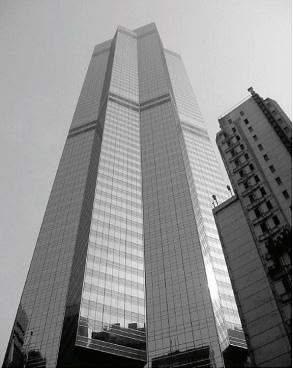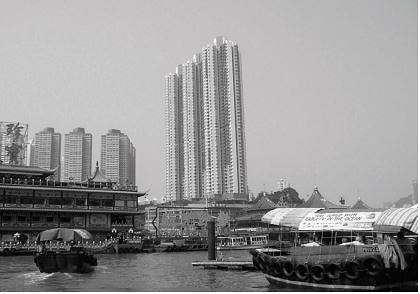HONG KONG
Entering Hong Kong from mainland China means filling out a customs form, even for the Chinese. As we went through security, we also cleared a temperature checkpoint, a familiar feature by now, as we had encountered similar devices at the reception desks of many hotels. Although Hong Kong became part of China in 1997, it still operates largely according to the British system, with its own dollar currency. National Day in Hong Kong is a one-day public holiday, as opposed to “Golden Week” on the mainland.
Our arrival fell on the 56th anniversary of the founding of the People’s Republic of China. Flags and flowers adorned city squares. Children wore traditional costumes and waved small national flags. Many headed for the newly inaugurated Disney World. People in a festive mood clogged up the streets as they moved toward the harbor for the evening fireworks. To avoid the crush of bodies at the harbor, my roommate and I enjoyed the fireworks from a distance, before returning to our hotel for a quiet dinner at one of its restaurants. Cod in champagne sauce was the culinary highlight of our trip.

Bank of China
The next morning our local guide, Alan, taught us a few words in Cantonese, such as “good morning” and “thank you”: jo son and ma goi doco, respectively. A tour of the city revealed a panorama of skyscrapers, including the Bank of China, designed by the renowned architect I.M. Pei, and luxury apartments renting for $4-8000 a month. 90% of the population, mostly Chinese, live in high-rises. The largest ethnic group are the Filipinos, who work as live-in domestics taking care of children and the elderly. Nepalese soldiers work as security guards. Our visit to the traditional Chinese district included a ride on the world’s longest covered outdoor escalator, and a bustling local market with butcher stalls, live fish tanks, bags of spices, mounds of sprouts, assorted shelled nuts, and baskets filled with vegetables and fruit, such as persimmons and yellow watermelons.
In the evening we took the Star Ferry to Hong Kong Island and rode up to Victoria Peak to gaze at the night view. The harbor shimmered in lights; the high-rise towers of Aberdeen presented a continuous light show of computer-generated patterns. We enjoyed a double-decker bus ride with locals. At the night market we browsed through stalls of jewelry, crafts, and racks of silk clothing. I bought a blouse for $3.
On our final day, we toured Kowloon and the New Territories, where 90% of land in Hong Kong is located. The highlights of this tour were the flower markets and the bird garden. Built as a redevelopment project, the garden is a theme park with bird stalls for traders. Men raise birds and gamble on the best singers or fighters. Once a week they feed live crickets to the birds to make them sing better. Fresh flowers are brought to market early in the morning and drop in price later in the day. Many flower and poultry farmers have moved to the UK or the Netherlands for job opportunities. The farmlands of 20 years ago have given way to high-rise buildings to accommodate people working in services and in garment, jewelry, and electronics factories. Due to limited land, ashes are kept in temples after cremation. Some bones are put in jars and left on a hillside, which farmers strengthen by building cement walls.
Chinese people are superstitious. Locals buy special paper money to burn in the temples for prosperity. The village of Lam is inhabited by people with the surname Lam, and is also known as the village of the Wishing Tree. At the Tin Hau Temple, we each bought a paper prayer tied to an orange with a string to fling onto a majestic banyan tree as we made a wish. We tossed our paper charms into the air, hoping they would catch onto the tree on the first attempt so that our wishes would be granted. Unfortunately, mine landed on the ground. The public restrooms at this site were the cleanest and most modern of any we had encountered in China. Freshly cut orchids above the washbasins were an irresistible subject for a photo.
During our free time I walked over to the Hong Kong Museum of Art, which has become a destination for countless treasures as historical circumstances in the last 50 years have brought collectors from all over China to the city. After viewing the antiquities, I was delighted to come upon witty installations by contemporary artists, whose works incorporated traditional techniques in innovative ways. “Ink Banquet” by Wang Tiande used chairs around a dining table set for eight, including a bottle per place setting. All furniture and dinnerware was wrapped in ink-washed paper that cast monochromatic hues of gray over the entire banquet. Xu Bing’s “A Book from the Sky” covered the ceiling with books paying homage to traditional Chinese bookbinding and printing techniques. Lau Siuhong Freeman’s “Agenda No. 1” was a commentary on the board room, with every chair around the table made of different material, including wood, rattan, steel, and metal mesh.
Our farewell dinner at the hotel was joyous as we celebrated new friendships and exchanged addresses. We left early in the morning for our return to the States. We flew back across the International Date Line and arrived home on the same calendar day.
China is a vast country, where each region has different dialects, customs, cuisine, folklore, and architecture. This article attempts to give a flavor of the regions I visited, from the northern heights of Tibet to the southern tip of Hong Kong, where people run rather than walk. The people’s willingness to work very long hours, seven days a week, underscores their desire to become a leading economic power. China is a country where tradition and innovation exist in harmony. The glazed, bamboo-shaped ceramic roof tiles of the pavilions in the imperial gardens recall the past, while the high-rises of Shanghai and Hong Kong Hong Kong Harbor embrace the future.

Hong Kong Harbor
→ Morocco
